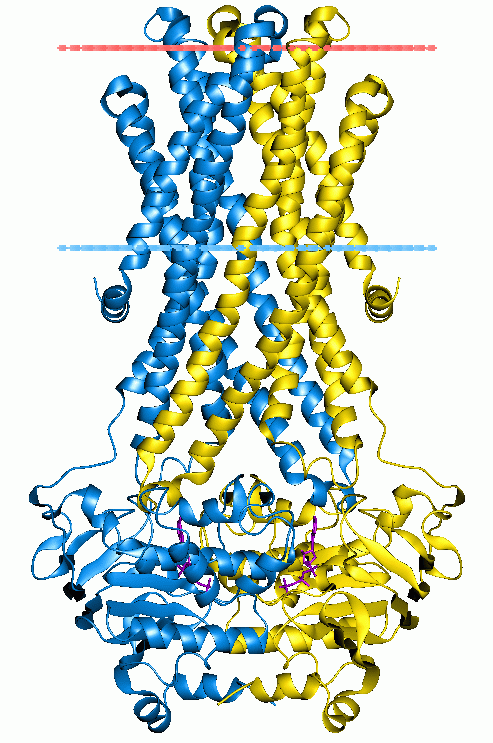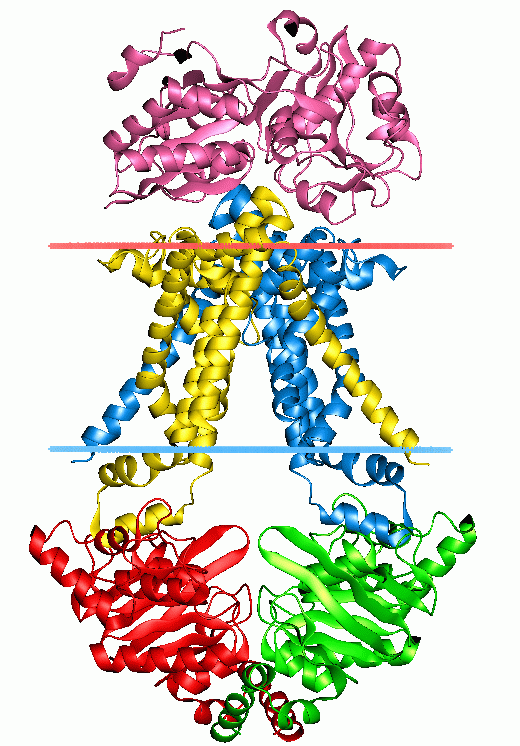ATP-binding cassette transporter



ATP-binding cassette transporters (ABC-transporter) are members of a a superfamily which is one of the largest, and most ancient families with representatives in all extant phyla from prokaryotes to humans. [1]. These are transmembrane proteins that function in the transport of a wide variety of substrates across extra- and intracellular membranes, including metabolic products, lipids and sterols, and drugs. Proteins are classified as ABC transporters based on the sequence and organization of their ATP-binding domain(s), also known as nucleotide-binding folds (NBFs). ABC transporters are involved in tumour resistance, cystic fibrosis, bacterial multidrug resistance and a range of other inherited human diseases.
Function
ABC-transporters utilize the energy of ATP hydrolysis to transport various substrates across cellular membranes. Within bacteria, ABC-transporters mainly pump essential compounds such as sugars, vitamins, and metal ions into the cell. Within eukaryotes, ABC-transporters mainly transport molecules to the outside of the plasma membrane or into membrane-bound organelles such as the endoplasmic reticulum, mitochondria, etc. More recently ABC-transporters have been shown to exist within the placenta, indicating they could play a protective role for the developing fetus against xenobiotics.
The range of transported compounds includes:
- Lipids and sterols;
- Ions and small molecules.
- Drugs;
- Large polypeptides.
Structure
Typical ABC-transporters will contain two transmembrane domains (TMs), each of which consists of α-helices which cross the phospholipid bilayer multiple times. These helices form between six to eleven (usually six) membrane-spanning regions. These transmembrane domains provide the specificity for the substrate, and prevent unwanted molecules from using the transporter. In between the TMs is a ligand binding-domain, which is on the extracellular side of the protein for importers and on the cytoplasmic side for exporters.
All ABC proteins also contain either one or two ATP-binding domain(s), (nucleotide-binding folds (NBFs)) and are located on the cytoplasm side of the membrane. These folds are divided into parts or motifs, called Walker A and Walker B, which are separated by approximately 90-120 amino acids. In addition, there is a third short and highly conserved motif (called LSGGQ motif, C motif, or "signature" motif) located after the Walker B motif. Unlike the Walker A and Walker B motifs, which are found in other proteins which hydrolyze ATP, the signature motif is unique to ABC transporters. Other conserved motifs include the Q-loop, the his-loop, the pro-loop and the D-loop. These folds form the “cassettes” which the protein family is named after. The transmembrane domains and nucleotide-binding folds are often arranged in the order NH3+-TM-NBF-TM-NBF-COO-.
Many ABC transporters may be classified as half transporters or full transporters. Full transporters consist of the typical two TMs and NBFs. Half transporters consist of only one TM and one NBF and must combine with another half transporter to gain functionability. Half transporters can thus form homodimers if two identical ABC transporters join, and heterodimers if two unlike ABC transporters join. However though these are the most common domain organisations, others exist. For instance many bacterial importers are composed of four polypeptides. Every possible organisation for these domains has been observed (Higgins, 1992).
Method of Operation
The mechanism of ABC transporters has not been fully identified. It is known that when an ATP molecule binds to each cassette of an ABC-transporter, it induces a conformational change in which the NBFs interact more closely. This is communicated to the TMs, which shift to re-orientate the translocation pathway. This action is called the power stroke. In this conformation, the substrate binding is lower affinity, and so the substrates can be released.
Particular areas of controversy include the roles of ATP binding, ATP hydrolysis and the subsequent dissociation of the ADP and Pi. Also unclear is how communication between the NBFs and the TMs takes place.
Role in Multidrug Resistance
ABC transporters are known to play a crucial role in the development of multidrug resistance (MDR). In MDR, patients who are on medication eventually develop resistance to not only the drug they are taking, but to several different types of drugs. This is caused by several factors, one of which is increased excretion of the drug from the cell by ABC transporters. For example, the ABCB1 protein (P-glycoprotein) functions in pumping tumor suppression drugs out of the cell. Pgp also called MDR1, ABCB1, is the prototype of ABC transporters and also the most extensively studied gene. Pgp is known to transport organic cationic or neutral compounds. A few ABCC family members, also known as MRP, have also been demonstrated to confer MDR to organic anion compounds. The best studied member in ABCG family is ABCG2, also known as BCRP (breast cancer resistance protein) confer resistance to most of Topoisomerase I or II inhibitors such as topotecan, irinotecan and doxorobicin.
It is unclear exactly how these proteins can translocation such a wide variety of drugs, however one model (the hydrophobic vacuum cleaner model) states that in P-glycoprotein the drugs are bound indiscriminately from the lipid phase based on their hydrophobicity.
Subfamilies
Human Subfamilies
There are 50 known ABC transporters present in humans, which are classified into seven families by the Human Genome Organization.
| Family | Members | Function | Examples |
| ABCA | This family contains some of the largest transporters (over 2,100 amino acids long). Five of them are located in a cluster in the 17q24 chromosome. | Responsible for the transportation of cholesterol and lipids, among other things. | ABCA12 |
| ABCB | Consists of 4 full and 7 half transporters. | Some are located in the blood-brain barrier, liver, mitochondria and transports peptides and bile, for example. | ABCB5 |
| ABCC | Consists of 12 full transporters. | Used in ion transport, cell-surface receptors, toxin secretion. Includes the CFTR protein, which causes cystic fibrosis when deficient. | ABCC6 |
| ABCD | Consists of 4 half transporters | Are all used in peroxisomes. | ABCD1 |
| ABCE/ABCF | Consists of 1 ABCE and 3 ABCF proteins. | These are not actually transporters but are merely ATP-binding domains which were derived from the ABC family but without the transmembrane domains. These proteins mainly regulate protein synthesis or expression. | ABCE:RLI |
| ABCG | Consists of 6 “reverse” half-transporters, with the NBF at the NH3+ end and the TM at the COO- end. | Transports lipids, bile, cholesterol, and other steroids. | - |
A full list of human ABC transporters can be found at [2].
Prokaryotic Subfamilies
Importers
- Carbohydrate Uptake Transporter-1 (CUT1)
- Carbohydrate Uptake Transporter-2 (CUT2)
- Polar Amino Acid Uptake Transporter (PAAT)
- Peptide/Opine/Nickel Uptake Transporter (PepT)
- Hydrophobic Amino Acid Uptake Transporter (HAAT)
- Sulfate/Tungstate Uptake Transporter (SulT)
- Phosphate Uptake Transporter (PhoT)
- Molybdate Uptake Transporter (MolT)
- Phosphonate Uptake Transporter (PhnT)
- Ferric Iron Uptake Transporter (FeT)
- Polyamine/Opine/Phosphonate Uptake Transporter (POPT)
- Quaternary Amine Uptake Transporter (QAT)
- Vitamin B12 Uptake Transporter (B12T)
- Iron Chelate Uptake Transporter (FeCT)
- Manganese/Zinc/Iron Chelate Uptake Transporter (MZT)
- Nitrate/Nitrite/Cyanate Uptake Transporter (NitT)
- Taurine Uptake Transporter (TauT)
- Cobalt Uptake Transporter (CoT)
- Thiamin Uptake Transporter (ThiT)
- Brachyspira Iron Transporter (BIT)
- Siderophore-Fe3+ Uptake Transporter (SIUT)
- Nickel Uptake Transporter (NiT)
- Nickel/Cobalt Uptake Transporter (NiCoT)
- Methionine Uptake Transporter (MUT)
- Lipid Exporter (LipidE)
Exporters
- Capsular Polysaccharide Exporter (CPSE)
- Lipooligosaccharide Exporter (LOSE)
- Lipopolysaccharide Exporter (LPSE)
- Teichoic Acid Exporter (TAE)
- Drug Exporter-1 (DrugE1)
- Lipid Exporter (LipidE)
- Putative Heme Exporter (HemeE)
- β-Glucan Exporter (GlucanE)
- Protein-1 Exporter (Prot1E)
- Protein-2 Exporter (Prot2E)
- Peptide-1 Exporter (Pep1E)
- Peptide-2 Exporter (Pep2E)
- Peptide-3 Exporter (Pep3E)
- Probable Glycolipid Exporter (DevE)
- Na+ Exporter (NatE)
- Microcin B17 Exporter (McbE)
- Drug Exporter-2 (DrugE2)
- Microcin J25 Exporter (McjD)
- Drug/Siderophore Exporter-3 (DrugE3)
- (Putative) Drug Resistance ATPase-1 (Drug RA1)
- (Putative) Drug Resistance ATPase-2 (Drug RA2)
- Macrolide Exporter (MacB)
- Peptide-4 Exporter (Pep4E)
- 3-component Peptide-5 Exporter (Pep5E)
- Lipoprotein Translocase (LPT)
- β-Exotoxin I Exporter (βETE)
- AmfS Peptide Exporter (AmfS-E)
- SkfA Peptide Exporter (SkfA-E)
- CydDC Cysteine Exporter (CydDC-E)
Images
A wealth of high-resolution structures of ABC proteins have been produced in recent years. [4]
References
- ^ Jones, P. M.; George, A. M.; Cellular and Molecular Life Sciences. 2004, 61, 682-699.
- ^ Dean, Michael. The Human ATP-Binding Cassette (ABC) Transporter Superfamily. Bethesda (MD):National Library of Medicine (US), NCBI; 2002 November.
- ^ Szentpétery, Z.; Kern, A.; Liliom, K.; Sarkadi, B.; Váradi, A.; Bakos, E.; J. Biol. Chem. 2004, 279, 41670-41678. [5]
- ^ ABC Nomenclature Committee. ABC-Transporter Genes nomenclature scheme, enacted October 22, 1999. Verified availability August 2, 2005.
- ^ Fitzgerald, M. L.; Okuhira, K.; Short, G. F.; Manning, J. J.; Bell, S. A.; Freeman, M. W.; J. Biol. Chem. 2004, 279, 48477-48485.
- ^ Wain, H. M.; White, J. A.; Povey, S. [6]
- ^ Saier MH Jr.; Microbiol Mol Biol Rev., 2000, 64(2), 354-411 TCDB
- ^ Deeley, R. G. [7]
See also
External links
- Classification of ABC transporters in TCDB
- UMich Orientation of Proteins in Membranes families/superfamily-17 - Calculated position of BtuCD transporter in membrane
- UMich Orientation of Proteins in Membranes families/superfamily-18 - Calculated position of multidrug transporter sav1866 in membrane
- UMich Orientation of Proteins in Membranes families/superfamily-198 - Calculated position of molybdate uptake transporter in membrane
- ATP-Binding+cassette+transporters at the US National Library of Medicine Medical Subject Headings (MeSH)